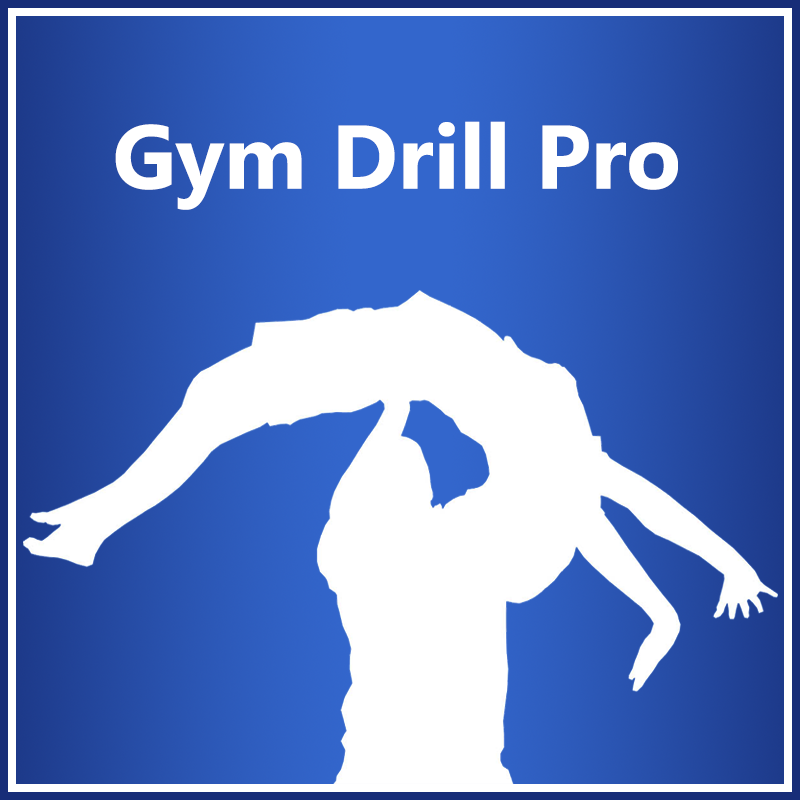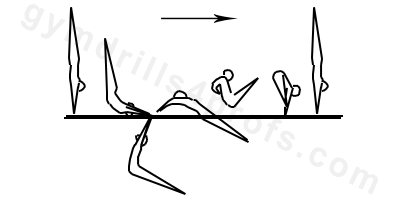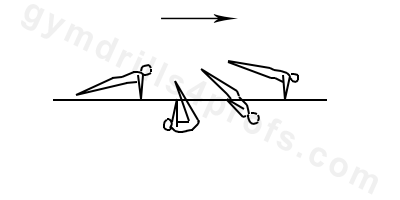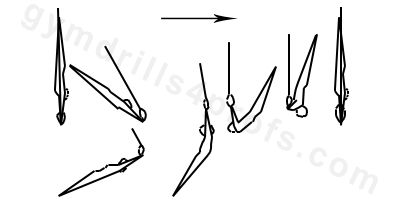

An integral part of the gymnastics coaching process is to provide athletes with drills to aid in their skill development. Drills can help gymnasts learn skills faster, and with the correct techniques. Gym Drill Pro aims to provide qualified coaches with a variety of teaching methods which they can introduce in their own training programs. On Gym Drill Pro you can find hundreds of detailed descriptions and accompanying images for every skill progression. This website is explicitly intended to support qualified coaches in their daily coaching processes. DO NOT practice any of these drills without the guidance of proper professionals.

From a handstand, the gymnast should start the skill with a tight arch bail. Their shoulders should be extended with the body arched from the hips. Once the gymnast gets to roughly bar level, they should kick their legs forward into a pike position and pass through the lower point of the swing. They should keep the pike position to avoid touching the ground. Their shoulders should be open during this phase, with their head in the middle position. Next, the gymnast should open their hips and kick them upward for the final move of the reverse hecht swing. From their arms they should push back strongly on the rails. This will help them to reverse the swing and release upward. Once the gymnast is above the bars, they should open their legs and straddle, grabbing the bars in front of their legs. Following this skill is a press handstand in motion. The skill finishes in handstand.

The Feldge / Peach / Basket can be performed with two modifications: freehip or stalder. The gymnast should perform a backward roll to candlestick or reversed pike. At this stage in the skill, it’s important that the hips are away from the gymnast’s hands. Simply said, it has to be a free hip, not a back hip circle. Keeping the hips far away helps the gymnast to obtain a wide circle, which will give them enough speed for the second part of the skill. If the hips are too close to the hands, the circle is cut short and as a consequence the skill will move slower. When the gymnast’s shoulders are at the lower part between the bars, the second part of the skill begins. The gymnast should gradually open the angle of the shoulders, push back on the rails, and open the body from pike to hollow. Pushing on the bars helps to stop the back flipping and transform it into a upwards momentum. This will raise the gymnast’s body to vertical. Opening the body from pike to vertical will help the gymnast accelerate the speed and send the direction up to handstand. The grip is inward and the gymnast should hold the rails for as long as possible. It helps to feel the support position and push on the bars. At the last moment of the skill, the gymnast should switch their hands and finish in a handstand position.

The front uprise L-sit is another EG3 skill. It is relatively easy because the move finishes in an L-sit. It starts from a front swing with a reverse hecht move. After the hanging position, the gymnast should open their hips and kick them upward in the final move of the reverse hecht. Their arms should push down strongly on the rings. This helps to reverse the swing and to raise the athlete onto the rings in a low rear support position. When the body reaches the horizontal, the arms should perform a half circle downward, the hips raise over the rings and the move finishes in an L-sit. The gymnast should emphasize on the strong hips kick upward in the front swing. At that moment the body should be arched. Also, the gymnast should keep in mind that after reaching horizontal, the arm circle from the arms should start. Both moves should be divided, first is the kick from the hips, then goes the arms circle.

The back giant on rings begins from a properly executed handstand. The bail should begin with the gymnast pushing the rings forward. The gymnast should maintain tension on the rings to reduce slack on the cables, and so that the swing can reach its maximum potential. The body should remain straight throughout the bail, until the gymnast is directly under the rings. At this point, the gymnast should keep a tight arch through the bottom of the swing while maintaining pressure on the rings. The gymnast should then kick their heels upward in a candlestick position as they begin the next part of the back giant. The body should turnover into an inverted vertical position, and the gymnast should put backward pressure on the rings. This will help the body rise into the handstand. The gymnast can push the rings outward to help put more pressure on the rings. The gymnast should finish the back giant in a controlled handstand.

The handstand is a very common skill. It can be static (held), or dynamic, where the gymnast passes through the handstand briefly. A handstand on rings is typically more difficult than other variations. This is because the rings themselves are not static, which means that the gymnast needs to have basic strength requirements in order to balance properly. The arms should be parallel at the width of the shoulders. Also, they shouldn’t touch the cables. The arms and legs should be completely straight. The shoulder angle should be completely extended. During the handstand, the butt and core should be tight, and the head should be in a neutral position with the eyes watching the hands. It’s very important not to watch the hands with the head back, as this can lead to arching through the entire back. The wrists are turned out, which allow the rings to be parallel and even overturned.